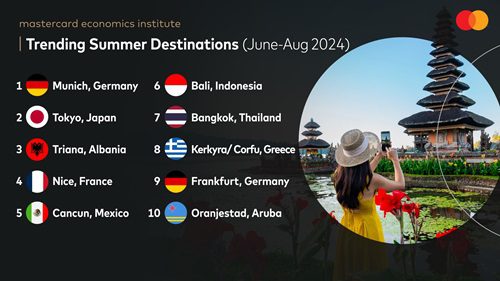 The Asia Pacific region is making a dramatic comeback as a premier travel destination, as revealed by the Mastercard Economics Institute’s latest report, “Travel Trends 2024: Breaking Boundaries.” This comprehensive analysis highlights the evolving landscape of the global travel industry, offering vital insights for travellers, businesses, and policymakers alike.
The Asia Pacific region is making a dramatic comeback as a premier travel destination, as revealed by the Mastercard Economics Institute’s latest report, “Travel Trends 2024: Breaking Boundaries.” This comprehensive analysis highlights the evolving landscape of the global travel industry, offering vital insights for travellers, businesses, and policymakers alike.
Record-Breaking Tourism in Japan
Japan has become the top trending destination worldwide, welcoming an astounding 3,081,600 international visitors in March 2024. Fueled by a weak yen, this record-breaking influx positions Japan as a clear frontrunner in the tourism sector. The favourable exchange rate has significantly boosted tourists’ spending power, benefiting local businesses and the broader Japanese economy.
David Mann, Chief Economist for Asia Pacific at Mastercard, emphasized, “Consumers in the Asia Pacific region have an intense desire and willingness to travel. They are becoming increasingly savvy, ensuring they get the best value and unforgettable experiences from their trips.”
Rebounding Passenger Traffic and Regional Travel
The report indicates a robust rebound in passenger traffic across the Asia Pacific region, particularly for shorter, intra-regional trips. Top destinations for travellers from Singapore include Bangkok, Kuala Lumpur, and Perth. This resurgence is a testament to the region’s growing appeal and the increasing ease of travel within APAC.
Thailand is another notable example, with its tourism sector expected to recover in 2024 fully. The country has seen a remarkable increase in inbound flight traffic from South Asia and the ASEAN region, nearly 20% above pre-pandemic levels.
Chinese Mainland: A Shift Towards Domestic Tourism
The travel dynamics on the Chinese mainland have shifted significantly, with a growing preference for domestic travel. Air passenger traffic within the Chinese Mainland has normalised and surpassed 2019 levels. This trend is a boon for local businesses and the domestic economy.
However, international tourism traffic from the Chinese Mainland is also on a steady path to recovery, now at 80.3% of 2019 levels. The continued easing of visa restrictions and increased international flight capacity are expected to boost outbound travel further, benefiting destinations like Singapore, Malaysia, and Thailand.
India’s Travel Boom
India is experiencing an unprecedented surge in travel, driven by a burgeoning middle class and increased route capacity. In the first quarter of 2024 alone, 97 million passengers travelled through Indian airports, a milestone that would have taken an entire year to achieve a decade ago.
Domestic passenger traffic in India has risen by 21% compared to 2019, while international passenger traffic is up by 4%. Key markets like Japan, Vietnam, and the United States have seen significant increases in Indian visitors, reflecting the country’s growing prominence in global travel.

Longer Stays and Greater Spending
Tourists in the Asia Pacific region are extending their stays, driven by the affordability of destinations, favourable exchange rates, and warm weather. On average, visitors now spend 7.4 days per trip, up from 6.1 days in 2019. This trend is particularly notable in India, Vietnam, Indonesia, and Japan, where extended stays contribute to higher local spending and economic benefits.
In Australia and New Zealand, overseas visitors stay for an average of 5.4 days, an increase from previous years. This shift towards more extended vacations translates into more significant spending per trip, benefiting local economies.
Thrill Seekers Prioritize Experiences and Nightlife
Globally, travellers continue to prioritize experiences over material goods. Spending on experiences and nightlife now accounts for 12% of tourism sales, the highest level in at least five years. Australian tourists lead this trend, with nearly 19% of their travel budget dedicated to experiences and nightlife activities.
Tourists from the Chinese Mainland are also increasingly seeking out experiences, with spending in this category rising from 7% in 2023 to 10% in 2024. This shift underscores a broader trend towards valuing unique and memorable experiences over traditional retail shopping.
Casual Fashion and Fine Dining Trends
Tourists remain strongly influenced by casual fashion and laid-back vibes, except in regions where luxury offers exceptional value. Luxury fashion sales have surged in Japan and Hong Kong SAR, with 152% and 208% yearly increases, respectively. This growth is partly attributed to Japan’s weak yen and robust inbound tourism.
In contrast, fine dining is flourishing in Australia, India, and Thailand, where premium dining experiences outperform casual dining. This trend highlights the evolving tastes and preferences of modern travellers.
Strategic Insights for Businesses and Policymakers
Amidst the evolving tourism landscape, the Mastercard Economics Institute provides actionable strategies for businesses and policymakers. By translating macroeconomic forces and data insights into practical plans, the Institute helps stakeholders navigate the complexities of the travel industry.
Visit the Mastercard Economics Institute’s website here for more detailed insights and the full “Travel Trends 2024: Breaking Boundaries” report.
Written by: Supaporn Pholrach

